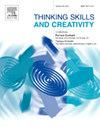Cross-domain analogical reasoning ability links functional connectome to creativity
IF 3.7
2区 教育学
Q1 Social Sciences
引用次数: 0
Abstract
Cross-domain analogical reasoning (CAR) is a potent cognitive tool that links seemingly unrelated knowledge domains, fostering creative thinking by identifying similarities across different fields. This study aimed to identify functional connectomes encoding individual variations in CAR abilities and assess their role in creativity. Participants included 69 typical university students who underwent resting-state brain MRI scans and behavioral tests. These tests assessed both CAR and within-domain analogical reasoning (WAR) abilities using verbal analogy tasks in the A:B::C:D format and measured individual creativity levels using the Alternative Uses Test (AUT). We employed a connectome-based predictive modeling (CPM) approach, utilizing the Power264 brain atlas to identify functional connectomes supporting CAR abilities. The CPM analysis indicated that the positive network model could reliably predict individual CAR scores. Functional anatomy and lesion analysis revealed that functional connectivity was broadly distributed across the brain. However, the default mode network, along with specific internetwork connections—such as between the salience and sensory/somatomotor mouth networks, and between the fronto-parietal task control and cingulo-opercular task control networks—showed preferential involvement. Moreover, mediation analysis suggested that CAR mediates the influence of brain functional connectomes on creativity. Our research provides evidence for functional neural markers of CAR and reveals a potential neuropsychological pathway for predicting creativity, whereby brain functional connectomes support creativity through CAR.
跨领域类比推理能力将功能性连接体与创造力联系起来
跨领域类比推理(CAR)是一种强有力的认知工具,它将看似不相关的知识领域联系起来,通过识别不同领域的相似性来培养创造性思维。本研究旨在识别编码CAR能力个体差异的功能性连接体,并评估其在创造力中的作用。参与者包括69名典型的大学生,他们接受了静息状态大脑核磁共振扫描和行为测试。这些测试使用A:B::C:D格式的口头类比任务评估CAR和域内类比推理(WAR)能力,并使用替代用途测试(AUT)测量个人创造力水平。我们采用了基于连接体的预测建模(CPM)方法,利用Power264脑图谱来识别支持CAR能力的功能性连接体。CPM分析表明,正网络模型可以可靠地预测个体的CAR得分。功能解剖和病变分析显示,功能连接广泛分布于整个大脑。然而,默认模式网络,以及特定的网络连接,如显著性和感觉/躯体运动嘴部网络之间,额顶叶任务控制和扣谷-眼任务控制网络之间,显示出优先参与。此外,中介分析表明,CAR介导了脑功能连接体对创造力的影响。我们的研究为CAR的功能神经标记提供了证据,并揭示了预测创造力的潜在神经心理学途径,即大脑功能连接体通过CAR支持创造力。
本文章由计算机程序翻译,如有差异,请以英文原文为准。
求助全文
约1分钟内获得全文
求助全文
来源期刊

Thinking Skills and Creativity
EDUCATION & EDUCATIONAL RESEARCH-
CiteScore
6.40
自引率
16.20%
发文量
172
审稿时长
76 days
期刊介绍:
Thinking Skills and Creativity is a new journal providing a peer-reviewed forum for communication and debate for the community of researchers interested in teaching for thinking and creativity. Papers may represent a variety of theoretical perspectives and methodological approaches and may relate to any age level in a diversity of settings: formal and informal, education and work-based.
 求助内容:
求助内容: 应助结果提醒方式:
应助结果提醒方式:


